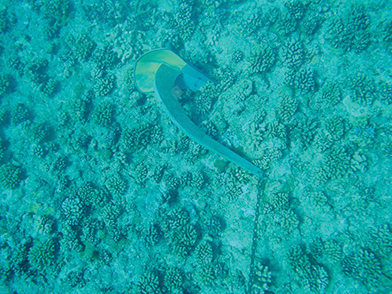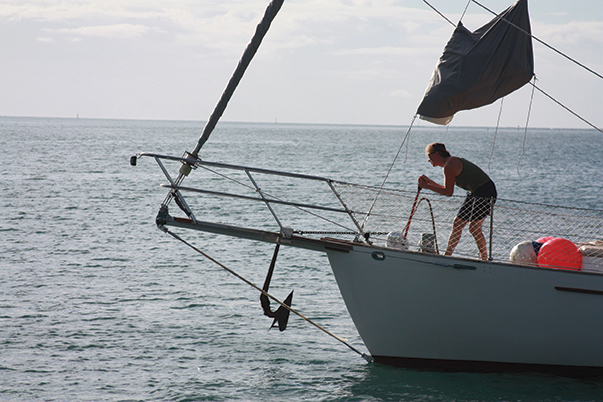There are lots of choices but some pretty obvious answers, too (published April 2017)
For cruising sailors who like to explore off the beaten path, anchors are their most important safety gear and insurance policy. If you are going to sleep well at night when anchored, you have to be confident in your anchors, your tackle and your windlass.
But not all anchors are created equal and not all bottoms are the same. As you explore the world you are going to run into some very different bottoms to hook into from sand, to rock and coral, to grass over sand to mud. And each type of bottom requires different qualities and capabilities from your anchors. That’s why experienced cruisers always carry three or four anchors of different types and at least three anchor rodes. Safety at sea is almost always about having the right skills, the right gear and redundancy and that is certainly true when considering your anchors.
 HOOKING ANCHORS
HOOKING ANCHORS
Until quite recently—1934 to be more exact—all anchors were either dead weights or hooks. The traditional anchor of a seaman’s tattoo is the proptype of a hooking anchor and we know it today as a fisherman anchor. It has two spade shaped hooks on opposite sides of the shank and a cross bar at the top of the shank to keep one hook pointed into the bottom. With luck, the hook would catch on something or, better yet, bury into the bottom.
But without surface area, a fisherman anchor will drag through mud or sand and will simply snag on kelp. In rock and coral, it will grab something hard. The anchor’s best quality is its abiliity to cut through sea grass and bury into the sand beneath it without getting fouled. Despite its use for centuries, the hooking fisherman anchor was never a secure way to hook your boat to the bottom.
In 1934, Geoffrey Taylor, a British mathematician, developed a new style of anchor based on the shape of an old fashion horse-drawn plow. His “articulated plow” became what we know today as the CQR and it is the first more or less modern hooking anchor. The anchor is still manufactured and many an old salt still swears by them. The rest of the fleet tends to swear at them, instead.
By design, a plow buries into the bottom and then has the ability under enough pressure to plow a furrow through sand and mud. Because of its blunt tip, it has trouble burying through sea grass. And, because of the way it buries to begin with, it takes a lot of pulling to reset itself when the wind changes. But for years, it was the cruising skipper’s anchor of choice.
It wasn’t until the early 70s that Scotsman Peter Bruce developed a hooking and burying anchor for use in the North Sea oil fields where the sea was too deep for rigs to stand on their own feet on the bottom. Instead, the rigs had to be anchored and held firmly in place, even in winter when seas can mount to 100 feet tall.
The hooking-burying anchor he developed is what we know now as the Bruce claw anchor and it rapidly gained acceptance by yachtsmen and cruisers. It sets very quickly in soft bottoms like sand and mud. It rolls over and resets quickly when the wind changes. It will hook coral and rocky bottoms with all three of its tines. But, it is not perfect.
Bruce anchors have the bad habit of grasping and picking up large stones in the claw, which renders the anchor useless. You have to haul it up and pry the stone loose and that can take some effort. Also, Bruce claw anchors harvest sea grass into bails that then clog the claw so it cannot bury in the sand beneath the grass. Still for many cruisers, the Bruce is their work horse anchor.
In the mid-80s, the British firm Simpson-Lawrence developed the modern plow which they called the Delta anchor. A hooking anchor with a sharp point and broad flukes, the Delta sets quickly and will do pretty well in grass and hard sand. It fits neatly on most bow rollers and offers a lot of holding power for its weight. The Delta’s weakness lies in its inability to roll over quickly to set if it hits the bottom upside down. It will tend to skip over the bottom until it happens on the right tip-down position; then, it sets quickly.
The Delta is now a standard anchor on most new boats, partly because it is relatively inexpensive and because it works pretty well. Many cruisers carry Deltas aboard their boat for anchoring in rock and coral and as a backup in grassy anchorages.
With the advent of the Delta, hooking anchor design continued to take leaps forward. In the 90s New Zealand cruiser, boat builder and inventor Peter Smith developed the Rocna hooking anchor. Pete took the good elements of the Delta, which he had used during a circumnavigation, and set out to improve upon the design.
The big design innovation that went into the Rocna is the arch over the top. This feature prevents the anchor from remaining upside down then it hits the bottom and quickly rolls it into tip down position so it can set quickly. The chisel shaped tip cuts through grass and kelp to reach the sand below and the concave fluke design holds onto the bottom much more securely than the plow shape of a Delta.
When the design was launched in New Zealand there were some issues with production and the company that Pete had engaged to build the anchors for him decided to go out on their own with a similar design called the Manson Supreme. The Supreme has the same roll bar and spear tip, but a different shaped fluke and a slotted shank that will make it easier to retrieve a snagged anchor.
The Rocna was picked up by a Chinese manufacturer and there were many serious quality issues among the first batches of anchors to hit the market; shanks were bending and welds were breaking. Today, the Rocna is under strict quality control and the anchors are among the best on the market.
A relative newcomer to the market is the Mantus hooking anchor, which is an evolution from the ideas that went into the Rocna and Supreme. The anchor has a large roll bar that attaches to short wings at the top of the fluke both of which help roll the anchor into the vital tip down position. The tip is a sharper chisel than on the Rocna or Supreme so it should bury through grass faster and more certainly. The fluke is flat in the middle with wings that form the low angled sides. This shovel shape offers a lot of holding power in soft bottoms.
In the past few years, the Mantus has developed an avid following and more and more reports appear to validate the quality of the design, the anchors setting properties and holding capabilities. One of the interesting things about the Mantus is that the shank and the roll bar are attached to the fluke with high quality, high strength nuts and bolts. While these will need to be inspected and tightened regularly, the design does mean that the anchor can be disassembled and stowed away neatly. So, if you need a very large storm anchor or want to carry an extra, spare anchor, this storability is very attractive.
 BURYING ANCHORS
BURYING ANCHORS
When we hear a forecast that a storm in bearing down on us, we tend to start looking for a nearby hurricane hole, deep river or the security of a lagoon. Inevitably, the bottoms in these anchorages are covered with silt, mud, soft sand and possibly shore side debris so you need to have onboard anchors that will perform their best in the soft stuff. Hooking anchors, for the most part, aren’t terribly good at this. You need burying anchors.
About the time that Geoffrey Taylor was coming up with the design of the CQR, Richard Danforth was working on design ideas for a light weight, fluke type burying anchor that would be useful in the soft sandy conditions of southern New England and Long Island Sound, the Chesapeake Bay, the rivers and bays of the Southeast, and the shallows of the Gulf of Mexico. His invention became the classic Danforth fluke anchor, which must be the most popular and most used anchor in North America.
With sharp points on the two flukes, a shank that sets the flukes at 32 degrees for optimum burying power and a cross bar across the top to keep the flukes oriented correctly, the Danforth is a technical and sophisticated design that caught on immediately. It will bury in sand, penetrate grassy bottoms, hold firmly in mud and will continue to bury as long as there is tension on the rode.
Occasionally, a Danforth anchor has to be cut away after a storm because it has buried so deeply it can’t be retrieved. Danforths and the knock offs that have come along are made of carbon steel with galvanized coatings so in time they will rust. And, unfortunately, Danforth style anchors do not fit neatly on bow rollers. For many cruisers, the Danforth anchor is a specialty tool that they bring out when conditions demand.
The Fortress aluminum fluke style anchor takes the design ideas that went into the Danforth and brings them squarely into the modern world. Developed in 1986, the Fortress is a lightweight, finely machined product that can be assembled and disassembled easily and has no welds to break. The Fortress has shown great holding power in soft bottoms and is much lighter than steel anchors of the same size.
One of the real innovations that went into the design is the ability to adjust the fluke angle from the normal 32 degrees to a whopping 45 degrees. This high angle gives the Fortress superior holding power in soft mud. Because of its holding power and because it can be disassembled and stowed away, many veteran cruisers think of their Fortress anchors as their hurricane hooks. But they also make great dinghy anchors because they offer a lot of holding power in a small package and don’t rust.
Last but not least, the Spade anchor is a kind of hybrid hooking-burying anchor that has developed an avid following in the cruising fleet. We put it the burying category because the size of the flukes and high arch of the shank allow the anchor to bury deeply into soft bottoms and provide excellent holding once buried.
The Spade will also perform as a hooking anchor but without the roll bar and sharp chisel tip that make some of the newer hooking anchors so effective. The anchor is known for easily self-launching off a bow roller. And, it can be taken apart and stowed at the bottom of a locker when its services are not needed. Because of that, the Spade has found a roll as a storm anchor and as the ultimate spare anchor. It comes in galvanized steel, stainless steel and, somewhat improbably, aluminum.

Before you head off cruising, prepare your boat and yourself with the anchors and rodes you will need to be safe and to sleep well when the wind is howling. Four anchors is not too many. We take two hooking and two burying with us because redundancy is the soul of seamanship.















